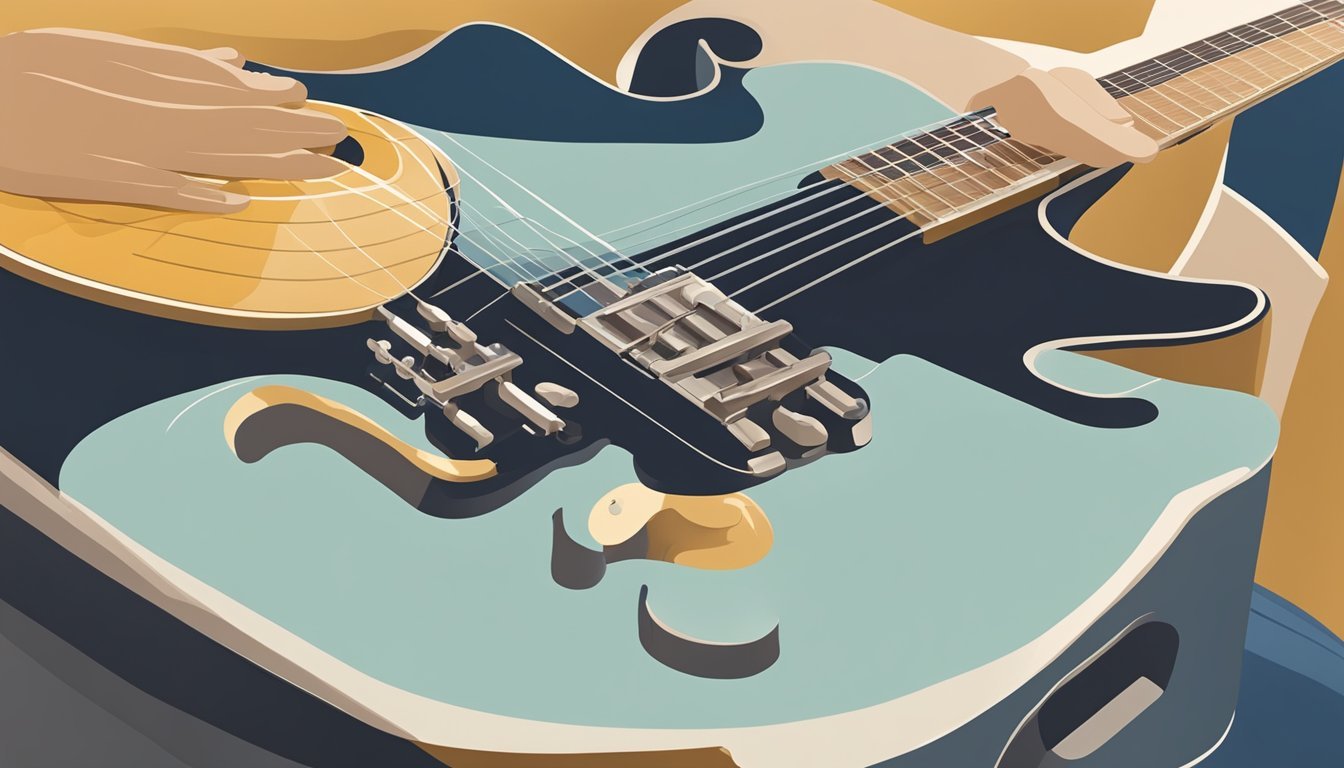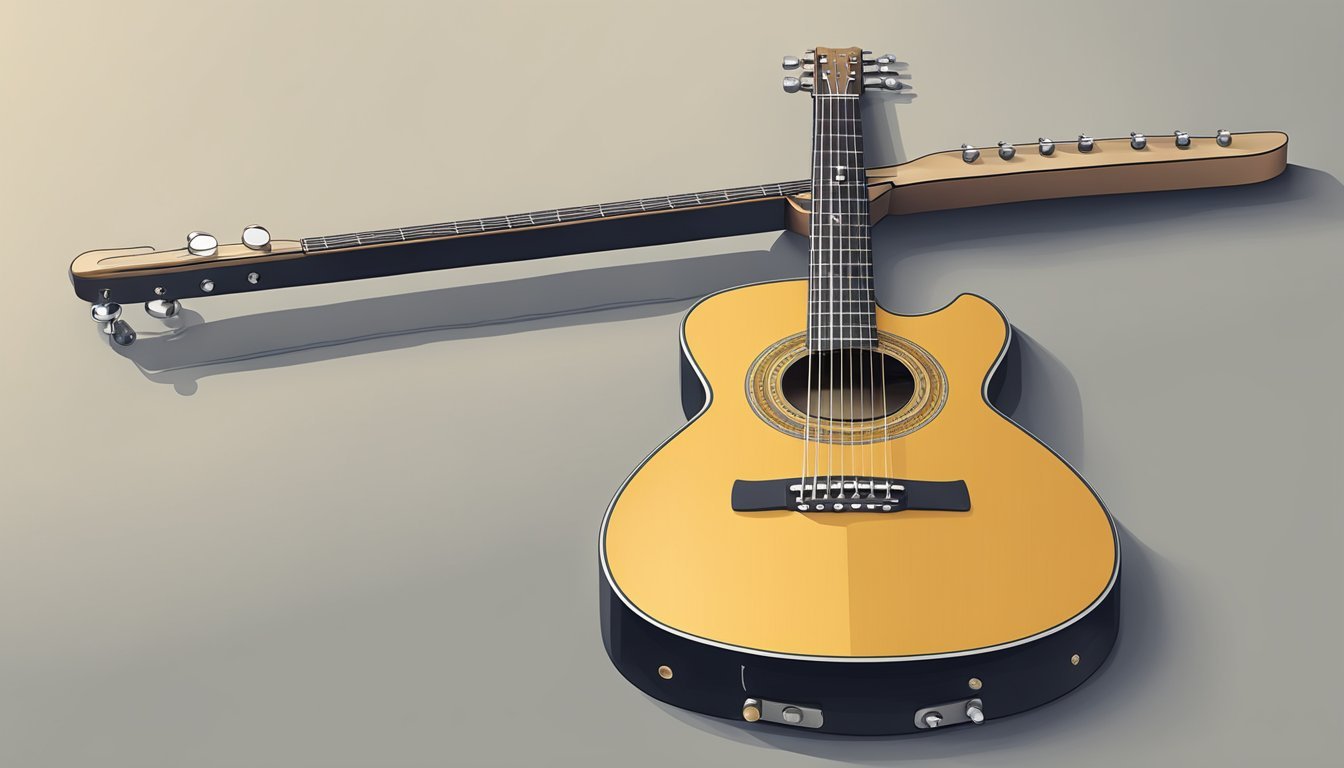Tuning your guitar without a tuner might sound tricky, but you can master it with a little practice.
You can tune your guitar by using your ear and simple techniques that rely on pitches from other strings or reference notes.
This approach not only helps you get your guitar sounding great, but it also trains your ear to recognize different notes, making you a better musician overall.

Whether you prefer acoustic or electric guitars, there are straightforward methods for achieving standard tuning.
You’ll learn how to use tuning pegs to adjust string tension and match pitches effectively.
Remember, maintaining your guitar in good shape also plays a big role in ensuring accurate tuning.
Ready to dive in and get your guitar sounding its best? Let’s explore the methods and tips that will have you tuning your guitar like a pro in no time.
Key Takeaways
- You can tune a guitar without a tuner using your ear.
- Maintaining your guitar helps in keeping it in tune.
- Learning to tune improves your musical skills and ear training.
Understanding Guitar Tuning Basics
Tuning your guitar means adjusting the strings to reach the right pitch.
Knowing the standard tuning and how the parts work will help you keep your instrument sounding great.
Identifying the Strings and Standard Tuning
Each string on your guitar has a specific name and standard pitch.
From the thickest to the thinnest, the strings are:
- 6th string (Low E)
- 5th string (A)
- 4th string (D)
- 3rd string (G)
- 2nd string (B)
- 1st string (High E)
Standard tuning sets these strings to the notes E, A, D, G, B, and E. When you pluck a string, it should resonate at these pitches.
Familiarizing yourself with these names helps ensure you can check your tuning easily.
How Pitch and Tuning Pegs Work
Each string is attached to a tuning peg on the headstock of your guitar.
You can tighten or loosen the string by turning these pegs.
Tightening the pegs raises the pitch, while loosening them lowers the pitch.
To get a string to the correct pitch, either pluck it and listen or use a reference note.
For example, plucking the 5th fret of the Low E string helps you tune the A string.
Adjust each peg until your strings match their corresponding pitches.
It’s essential to regularly check your tuning, especially before performances, as changes in temperature and humidity can affect string tension.
Additionally, once you’re comfortable with tuning, you can start learning how to strum a guitar properly, which will enhance your playing experience.
Practicing various strumming patterns can create a fuller sound and improve your overall musicianship.
Effects of Temperature and Humidity
Temperature and humidity can change how your guitar stays in tune.
Heat can cause wood to expand, making strings play flatter.
Meanwhile, cold often has the opposite effect, causing strings to play sharper.
Similarly, high humidity can affect the wood.
A damp environment makes it swell, which can change string tension.
To keep your guitar stable, try to store it in a controlled environment, avoiding extremes in humidity and temperature.
Keeping an eye on these factors can make your tuning much easier.
Tuning Techniques Without a Tuner
Tuning your guitar without a tuner is a handy skill.
You can use your ears, reference notes, or some simple methods to get the perfect sound.
Here are a few effective techniques to help you tune your guitar accurately.
Using Reference Notes and Tuning Forks
One way to tune your guitar is by using a reference note.
A tuning fork or a pitch pipe can be great tools for this purpose.
To start, strike the tuning fork to produce a note, usually the low E (the sixth string).
Place the fork near your guitar to hear the pitch clearly.
Now, match your low E string to the sound of the fork.
Adjust the tuning peg until both sounds are the same.
Once your low E is tuned, you can use this string to tune the rest.
For example, play the fifth fret on the low E to get the A note for the fifth string.
Keep following this pattern to tune the others.
This method helps you establish a solid base note to work from.
The Fifth Fret Method
The fifth fret method is another simple technique.
It uses the notes you play on the guitar itself to find the right pitches.
Start by tuning your low E string to your reference note.
Next, press down on the fifth fret of the low E string.
This note is an A, which you’ll use to tune the open A string (the fifth string).
Make them match in pitch.
Continue this way, using the fifth fret of the A string to tune the D string.
The only exception is when you reach the B string.
For this string, you’ll press the fourth fret of the G string to tune the B string.
This method relies heavily on intervals like perfect fourths, making it easier to find the right notes.
Harmonics Tuning Method
Using natural harmonics is a more advanced method but can be very effective once you get the hang of it.
This method exploits the physics of string vibration to find the right pitch.
To start, lightly touch the string above the fifth fret on the low E string without pressing down.
Then pluck it to hear the harmonic sound.
Do the same for the seventh fret on the A string.
Compare the two sounds; they should match.
Adjust the A string until you achieve the same pitch.
Repeat this for the D and G strings, using similar fret positions.
Harmonics help you focus on pure pitches without the background noise that can make tuning harder.
Learning to Tune by Ear
Trusting your ears is a valuable skill in tuning.
This method lets you rely on your sense of pitch to get your guitar in tune without any tools.
Start by playing an open string, then compare it to another string that you know is in tune.
It could be the low E. Listen closely to how they sound together.
The goal is to hear a clear and harmonious sound.
Once you get familiar with the sounds, you can adjust strings until they match perfectly.
Learning to tune by ear takes practice, but over time you’ll become more confident in identifying pitches.
Being able to tune your guitar this way can make performances and practice much smoother.
Maintaining Your Guitar for Accurate Tuning

Keeping your guitar in good shape is essential for tuning accurately.
This section covers important factors like string condition, noise levels, and how to optimize your guitar’s setup.
Dealing With Old Strings
Old strings can make it tough to keep your guitar in tune.
They often sound dull and can be difficult to tune accurately.
Strings lose their elasticity and tone over time, affecting sound quality.
To make sure your guitar stays in tune, check your strings regularly.
If they have rust, grime, or discoloration, it’s time to change them.
It’s usually best to replace your strings every few weeks, depending on how often you play.
When putting on new strings, remember to stretch them gently after installation.
This helps them settle and stay tuned longer.
Fresh strings enhance your sound quality, making it easier to tune your guitar accurately.
Minimizing Background Noise
Background noise can be a real headache when tuning.
It can interfere with your ability to hear your guitar clearly.
To tackle this, find a quiet spot when tuning your instrument.
Using clip-on tuners or electronic tuners can help, as they often filter out background sounds.
If you don’t have a tuner, try to isolate the open strings when tuning by using harmonics.
You might also want to turn off any nearby electronics that produce noise, like TVs or radios.
A calm environment helps you focus and hear subtle differences in pitch.
This makes tuning your guitar a lot easier and more accurate.
Optimizing Your Guitar’s Setup
A well-set-up guitar can significantly improve tuning stability.
Start with the neck relief; ensuring your guitar neck is straight allows for better string action.
Adjust the truss rod if necessary for comfortable playability.
Next, check the bridge and saddle heights.
Correct adjustments here can lead to better intonation, which helps your guitar sound in tune across all frets and when using open strings.
A guitar tuner can guide you in making these adjustments.
Don’t forget to also inspect your nut.
If the strings are too high or too low, it can affect tuning and playability.
A proper setup means your guitar stays in tune longer, giving you a better playing experience.
Frequently Asked Questions
Tuning a guitar without a tuner might seem tricky, but with the right methods, it can be easy.
Here are some common questions and answers to help you get your guitar sounding just right.
What’s the trick to tuning a guitar by ear?
To tune a guitar by ear, the most useful trick is to use reference pitches.
You can either use a piano, a tuning fork, or even another guitar.
For example, you can start by tuning the low E string to a reference note and then match the other strings based on that.
Can you tune a guitar to itself without any tools?
Yes, you can tune a guitar to itself without any tools.
This is usually done through relative tuning.
Start by tuning your low E string to a reference pitch, then use the 5th fret method to match the pitch of the other strings.
What’s the easiest method to tune a guitar without a tuner?
One of the easiest methods involves using your 5th fret.
For all strings except the B string, play the 5th fret of one string and match the open next string to it.
For the B string, play the 4th fret of the G string and tune the open B string to that note.
Are there any mobile apps for tuning guitars, and how accurate are they?
Yes, there are several mobile apps for tuning guitars, and many of them are quite accurate.
Some popular options include GuitarTuna and Fender Tune.
These apps use your phone’s microphone to detect pitches and help you tune your guitar effectively.
How can I know if my guitar is in tune without any devices?
You can tell if your guitar is in tune by playing some simple songs that you know well.
If the notes sound harmonious, your guitar is likely in tune.
You can also use the relative tuning method with another instrument.
What are some tuning techniques if I don’t have a tuner handy?
If you don’t have a tuner, try using the 5th fret method, as mentioned before.
You can also use harmonics for tuning.
Lightly touch the string above the 5th fret and compare it to the 7th fret of the next string.
Adjust as needed to match the pitches.

